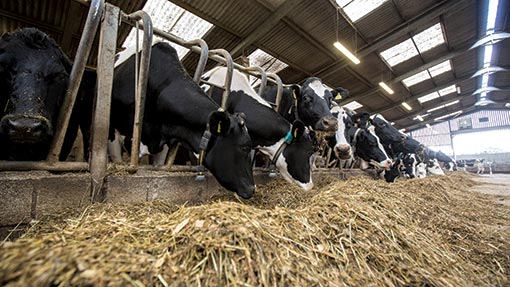Lower feed costs could temper milk price cuts

Balancing rations is going to be more challenging this winter as a result of quality varying between first- and second-cut grass silages.
But lower feed costs present dairy farmers with an opportunity to balance diets cost effectively and reduce the effects of milk price cuts.
Many processors have cut prices, which has seen the farmgate price paid for liquid milk fall below the cost of production.
Combined with the inconsistent quality of first-cut silage, the situation is being compared with 2012.
However, speaking at a ForFarmers dairy conference in Oswestry, independent nutritionist Hefin Richards of Profeed Nutrition stressed there was more opportunity to balance ration costs this year as a result of lower cereal prices.
“There was massive [upward] pressure on feed prices in 2012, so there was very little room to counter the feed quality. It was the most challenging, difficult winter I had seen in 20 years.”
By comparison, this year feed prices are significantly lower than in 2012, he said.
“On the whole, forage is much better this year. There were challenges with later first cuts, but maize potential is excellent and forage shortages are not likely this year.”
He said the “golden figure” to concentrate on this season was margin over feed. “That’s the figure that pays every other bill you have [after feed],” he added.
As a starting point, he said farmers needed to get stocks measured and analysed. If farmers have a heap of dry silage in one clamp and wetter silage in another, it may be wise to feed them together, he said.
“Don’t just look at the forage you have open at the time – look at the whole picture,” he added.
There may be an opportunity to open two clamps at once and feed the best-quality silage to milkers and more mature forage to youngstock and dry cows, he explained.
Mr Richards said there would be a desire to buy in concentrates based on the price per tonne, but he stressed any purchased feeds must provide value for money.
“It isn’t all about price per tonne – it is about having the right product to balance rations.”
Farmers with wet silage should not overfeed cereal, he warned.
“Starchy cereals with a high-acid silage will lead to acidosis. Be careful how much rolled cereal you feed with wet silage.”
On the other hand, mature silage will require an energy boost and cheap cereals such as wheat and barley will provide this.
If cereals were being increased in rations, he advised monitoring cows’ rumen health even more closely this winter to prevent acidosis.
Maize
With maize, he warned against rushing to open maize clamps to lift milk yield.
“We are going to be introducing maize and in so many cases it will be introduced too quickly. It needs time to ferment and stabilise to get the most from it.”
Ideally, he advised maize clamps shouldn’t be opened for at least eight weeks after harvest and it should be introduced into the ration in small steps. For example, if you’re aiming to feed a ration of 50-50 grass silage and maize, introduce maize in three steps.
See also: Save silage and make most of cheap cereals, beef farmers told
